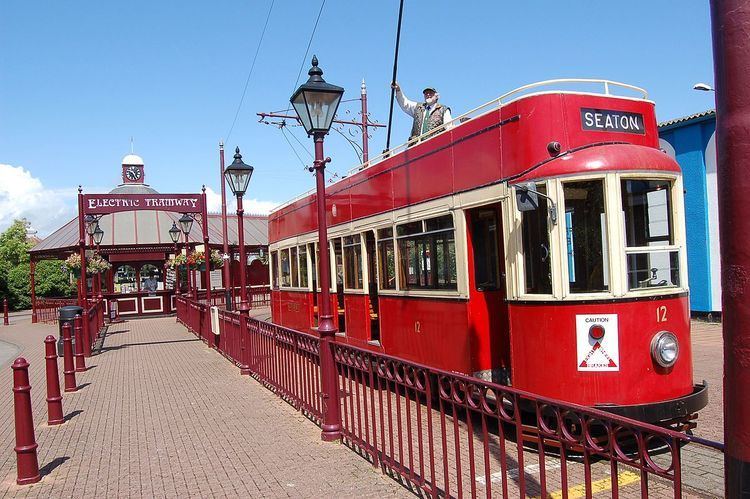Original gauge 2 ft 9 in (838 mm) Length 3 mi (4.8 km) Preserved electrification 120 V DC overhead wire Locale Devon | Original electrification 120 V DC overhead wire Preserved gauge 2 ft 9 in (838 mm) Phone +44 1297 20375 | |
 | ||
Hours Closed now Saturday10AM–5PMSunday10AM–5PMMonday10AM–5PMTuesday10AM–5PMWednesday10AM–5PMThursday10AM–5PMFriday10AM–5PMSuggest an edit Similar Weston‑super‑Mare Tramways, Douglas Bay Horse Tramway, Pecorama, Kingsway tramway subway, Lancaster Carriage and Wag Profiles | ||
Le tramway de seaton seaton tramway trams cab ride narrow gauge railway uk south devon tourism
The Seaton Tramway is a 2 ft 9 in (838 mm) narrow gauge electric tramway which operates over part of the route of a former London & South Western Railway branch line to Seaton, Devon. The line was converted between 1969 and 1971 by Claude Lane, who had bought the line from British Rail and had successfully operated trams in Eastbourne as a visitor attraction.
Contents
- Le tramway de seaton seaton tramway trams cab ride narrow gauge railway uk south devon tourism
- Seaton tramway 2015
- History
- References
The 3-mile (4.8 km) route runs through East Devon's Axe Valley, between the coastal resort of Seaton (Seaton Tram Station) and the small village of Colyford and the ancient town of Colyton.
Thirteen tram cars are part of the visitor attraction which sees about 80,000 visitors per year. The tram cars are half-scale (1:2) replicas of classic British tram cars from various cities; some were rebuilt from full-size cars which originally ran on other networks. Number 19 is the only tram from the Exeter tram system which is still in service.
Seaton tramway 2015
History
Claude Lane was the owner of the Lancaster Electrical Company of Barnet, a manufacturer of battery electric vehicles. His hobby was trams, and in 1949 he constructed a portable 15 in (381 mm) gauge tram system that he displayed at garden fetes and with semi-permanent sites at St Leonard's in 1951 and Rhyl from 1952 to '56. In '53 he agreed a lease at Eastbourne for a permanent 2/3rd mile-long 2 ft (610 mm) gauge system in the name of Modern Electric Tramways Ltd. The first new 2 foot gauge tram, now Seaton's Nº6, was ready for the 1956 season. By '57, Eastbourne was successful and he closed the Rhyl operation in order to concentrate on a single line. Cars 6, 7, 4, 2 & 12 were all constructed for the Eastbourne line.
By the mid 1960s, Lane was seeking a freehold site for a longer line and was also considering a large gauge, allowing roomier and more stable cars. Car Nº 8 was also constructed and run at Eastbourne, the first with an enlarged body anticipating a change to 2 ft 9 in (838 mm) gauge. This extra space is particularly noticeable with the internal staircases at each end of the car. The Beeching Axe was in full swing and the railway branch line to Seaton was closed in 1966. Negotiations to first purchase the site, then to obtain the necessary permission for the tramway took some time and was not granted until December '69. The tramway relocated over the closed Winter season of '69–'70.
The new line opened on 28 August 1970, just in time for the end of the holiday season. It was laid to the new gauge of 2 ft 9 in (838 mm) and car 8 had been regauged to suit. This initial opening was very limited: the line only went as far as the newly christened 'Bobsworth Bridge', for the price of a shilling. As no overhead electrical supply had been constructed yet, the tram ran with a battery trailer behind it. Services closed early in September 1970, to allow further work to be completed including the extension to Colyford, erection of overhead supply poles and the gauge conversion of other rolling stock. A full season in 1971 was eagerly anticipated, but Claude Lane suffered a fatal heart attack on 2 April 1971. The line was extended to Colyton to 1980.
